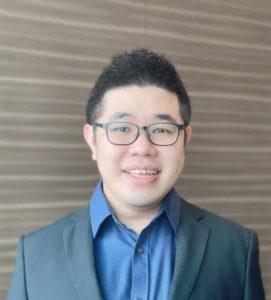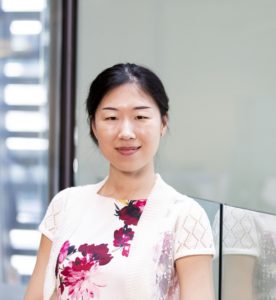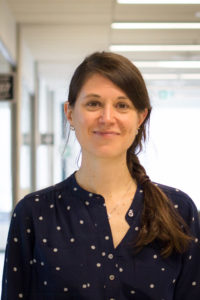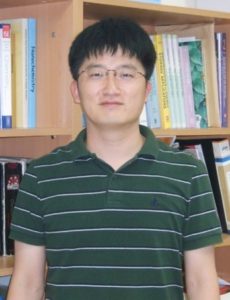This year we are pleased to celebrate 10 years since Journal of Materials Chemistry was split into three respective journals: Journal of Materials Chemistry A, B and C, each focusing on a different aspect of materials chemistry. We are grateful to our fantastic community of authors, reviewers, Board members and readers and wanted to showcase just some of them in a series of ‘Community Spotlight’ blog articles.
Next in our ‘Community Spotlight’ series, we feature some of our outstanding peer reviewers who have gone above and beyond in supporting the quality, timely and rigorous peer review model for Journal of Materials Chemistry A, B or C over the years. Check out their interview responses below to find out why they like reviewing for the journals and to discover their top advice for first-time authors and reviewers.
Dr Ady Suwardi

Ady Suwardi received his PhD from University of Cambridge, UK, and B.Eng from Nanyang Technological University (NTU), Singapore. He is currently a group leader in A*STAR and also an Adjunct Assistant Professor in the department of Materials Science and Engineering (MSE), National University of Singapore (NUS), Singapore. His main research area focuses on fundamental thermal and electronic properties of sustainable energy materials such as thermoelectrics, as well as their recycling, manufacturing, and device applications. He has a h-index of 27 and has published a total of >80 papers, with >30 corresponding/first authored papers in prestigious journals such as Nature Electronics, Advanced Materials, ACS Energy Letters, and Journal of Materials Chemistry A. He features in the Nanoscale and Journal of Materials Chemistry A Emerging Investigator series 2022. He currently serves in the early career editorial board in Materials Today Energy and youth editorial board in Soft Science. He has also served as a referee for more than 160 articles in 30 different peer-reviewed journals including prestigious journals such as Science, Angewandte Chemie, and Journal of Materials Chemistry A. He is also the recipient of an outstanding reviewer award from Journal of Materials Chemistry A in 2020. Beyond academics, he is a recipient of a Singapore National Award from the Prime Minister Office for his technical contributions during the COVID-19 crisis. |
What encouraged you to become a reviewer for Journal of Materials Chemistry A?
When I first published in Journal of Materials Chemistry A back in 2020, I was very impressed by the rapid processing time and the quality of reviewers’ comments. Many people believe that quality takes a long time, but I have seen that in this journal, it is possible to have both quality and speed in the editorial and review process. Long story short, the smooth experience in publishing with the journal motivated me to sign up as the reviewer. My main motivation at the time was to give back to the energy community (especially in thermoelectrics and piezoelectrics) by helping to review some of the manuscripts. I am also heartened by the various gestures by the journal, such as sharing the final decision of the manuscript, as well as getting to see comments from other reviewers. This simple gesture has largely create the feeling of inclusivity for reviewer like myself. In addition to this, it is also a personal excitement for me to have the first-hand knowledge on the latest development within my research field. This has certainly helped me to better plan my own research and formulate the right scientific question.
What has been your biggest learning point from reviewing?
Having the opportunity to sit “on the other side” of the publishing process, I have had wonderful opportunities to see things from the eyes of reviewers. For instance, I have personally learnt to improve the quality of my own review by looking at the comments from other reviewers which was kindly shared by the journal. Importantly, looking at manuscript from reviewers’ perspective have also tremendously improved my own manuscript quality. When writing my own paper, I take conscious effort to think and see from the readers’ perspective. For example, innocuous habit like grouping all figures together at the end of the manuscript creates unnecessary trouble for some reviewers, having to scroll back and forth throughout the manuscript. On the other hands, I have personally learned some good habits in responding to reviewers’ comments from some of the manuscripts which I helped to review. For instance, by attaching the important changes in the manuscript directly in the response letter can greatly save the reviewer’s time and efforts to locate the specific changes made in response to a specific comment. Overall, as an early-career PI, I feel that I have gained more than what I give through my active involvement in peer review.
Prof. Jiao Jiao Li

Dr Jiao Jiao Li is a biomedical engineer and medical scientist. Her research in tissue engineering and regenerative medicine aims to develop new therapies for chronic diseases, particularly those affecting musculoskeletal tissues using a combination of approaches including stem cells, biomaterials, nanotechnology, and more. She is a Senior Lecturer and Research Group Leader at University of Technology Sydney (UTS). She was a recent National Health and Medical Research Council (NHMRC) Early Career Fellow, and Co-Deputy Director of the Australian Research Council (ARC) Training Centre for Innovative BioEngineering. She was selected by Science & Technology Australia as a 2021-22 Superstar of STEM – one of 60 Australian women to serve as national role models for the community. Jiao Jiao’s work has been recognised by >30 inter/national awards, including in 2022 the NSW Young Tall Poppy Scientist of the Year and Premier’s Prize for NSW Early Career Researcher of the Year (Physical Sciences) for her nationally significant contributions to research excellence and social impact, and being named as Australia’s Top 20 Under 40 Researchers. She was also the Australian winner of the international Falling Walls Lab competition in 2021. Jiao Jiao has a passion for disseminating science in the community, and for raising up the next generation of secondary and tertiary students for their future careers and leadership in STEM. |
What encouraged you to become a reviewer for Journal of Materials Chemistry B?
Journal of Materials Chemistry B gets a lot of high quality submissions from the biomaterials field. As someone who was initially trained as a biomaterials scientist, I love seeing the latest cutting-edge work in the field. I have reviewed many papers for the journal in my interest area of tissue engineering, many of which were from groups conducting the most innovative work in this area, and have learnt a lot from these latest developments. I very much appreciate the journal’s efficient and transparent peer review process. By looking at my comments compared to those of other reviewers and the editor’s decision on manuscripts, I have learnt a lot about the peer review process and how to optimise the quality of my own manuscripts. Reviewing for the journal has also taught me to appreciate differing opinions, particularly when I was invited to provide an adjudicating review for manuscripts with conflicting reviewer reports. I am proud to say that reviewing for the journal has almost grown up together with my academic career, and that I have helped contribute to the growth of Journal of Materials Chemistry B as a major outlet for high quality papers in the biomaterials field.
Do you have any advice for first-time authors seeking publication in the journal?
I find that the best original research papers all share some common characteristics: 1) the work conducted was innovative or gave new insights into what was previously not known in the field, 2) the characterisations or analyses were directly relevant to proving a central point, and were performed with scientific rigour to good breadth and depth, and 3) the manuscript was written in a way that captures the latest advances relating to the subject matter, and clearly explains the significance of the work to a possibly generalist scientific audience. The editors of the journal always find reviewers who have specific expertise in the topic area of the manuscript, so the manuscript needs to well explain the specific novelty/significance of the study compared to the latest advances or what is already known/has been done. To some extent, the same applies for review papers as these also need to offer new insights or perspectives, or feature a unique collection of literature compared to existing reviews on the specific topic area.
Dr Eva Hemmer

Dr. Eva Hemmer is an Associate Professor of Materials Chemistry at the University of Ottawa. She received her PhD (2008) in materials science from Saarland University (Germany) under the mentorship of Prof. Sanjay Mathur. During her PhD she focused on the synthesis of lanthanide alkoxides and their decomposition to lanthanide-containing inorganic nanomaterials. This experience was further deepened during her postdoctoral studies when she worked on lanthanide-doped nanoparticles for near-infrared bioimaging with Prof. Kohei Soga (Tokyo University of Science, Japan, 2009-2012). In 2013 she was awarded a Feodor Lynen Research Postdoctoral Fellowship from the Alexander von Humboldt Foundation to work in the groups of Profs. Fiorenzo Vetrone and Francois Légaré at INRS-EMT (Université du Québec, Canada, 2012-2015) to develop nanothermometers based on upconverting nanoparticles. In winter 2016 she came to Ottawa in order to design and study novel multifunctional lanthanide-based nanocarriers for biomedical and energy conversion applications at the Department of Chemistry and Biomolecular Sciences. |
What encouraged you to become a reviewer for Journal of Materials Chemistry C?
I started reviewing for Journal of Materials Chemistry C when I was a postdoctoral fellow. One of my mentors, who was an editor, encouraged me to become a reviewer. I remember that I was quite nervous about it at the beginning. But I quickly started to enjoy reviewing as it is a great opportunity to get to see brand new research in materials chemistry that is also relevant to my own work on optical nanomaterials. The fact that JMCC shared the comments made by other reviewers as well as the final decision was very helpful and took away my initial uncertainty; it helped me to get better (I hope so 😊) in writing reviews and also to improve my own manuscript writing (I often ask myself what questions the reviewer might ask).
What would you recommend to new reviewers to ensure their report is helpful?
In my opinion, a helpful report provides constructive criticism. I have been lucky as an author to have received reviewer comments that helped to make the paper stronger. On the other hand, nothing is more frustrating than a one-liner rejection. My advice for new reviewers would be to accept review invitations for manuscripts about a topic that aligns very well with their own expertise, before getting into more complementary research fields. Also, only accept an invitation if you have the time to carefully read the manuscript and to write a detailed report in time.
Prof. Seung Uk Son

Prof. Seung Uk Son is currently working for the Department of Chemistry in Sungkyunkwan University, South Korea. He majored in organometallics and received his Ph. D in 2001 from Seoul National University, South Korea. He collaborated with Prof. Young Keun Chung, Prof. Taeghwan Hyeon, and Prof. Dwight A. Sweigart on organometallics and nanomaterials. He joined Sungkyunkwan University in 2005. His present research focuses on morphology-engineered microporous organic polymers (ME-MOPs) for environment, energy, and bio-applications. He is serving as an Advisory Board member of Journal of Materials Chemistry A and Materials Advances. |
What do you like most about being a reviewer for Journal of Materials Chemistry A?
Compared with my reviewer experience for the journals of other publishers, the prompt efforts of the editorial office were the most impressive point for me. The fast decision including adjudicative cases and the handy communications from the editorial office have made my reviewing process comfortable. From the statement of authors, I could figure out easily the key intention of authors, which was another good point in the reviewing process of Journal of Materials Chemistry A.
Do you have any advice for first-time authors seeking publication in the journal?
I think that Journal of Materials Chemistry A is a representative materials chemistry journal of the Royal Society of Chemistry. The meaning of materials chemistry papers can be analysed from the aspects of synthesis or functional performance. If authors explain the meaning of works from these aspects (usually one of them), it will be very helpful for reviewers to figure out the meaning of works. In the case of synthesis, the novel synthetic point can be appealed, especially, compared with the previous work of authors or literature. For application performance, simple record competition without corresponding scientific logic and principles was not persuasive for me to understand the meaning of work. Thus, I think that the new principle is important rather than the technical record comparison. Moreover, without beating performance records, the trial and suggestion of new scientific principles can be sufficiently welcomed.
Prof. Shinn-Jyh Ding

Prof. Shinn-Jyh Ding is a faculty member at the Institute of Oral Science at Chung Shan Medical University, Taiwan. He received his Ph.D. in Materials Science from National Cheng Kung University, Taiwan (1999) on the topic of hydroxyapatite-based gradient composite coatings by plasma spraying and magnetron sputtering. Since 2015, he has been honored as a guest professor at University of Debrecen, Hungary. Research interests include surface modification of metallic implants, biomimetic bone cements, and biocomposites for load-bearing applications. |
Do you have any advice for first-time authors seeking publication in Journal of Materials Chemistry B?
While the novelty and impact of a manuscript are the first things to be noted, the presentation of figures and tables is also extremely important to a good manuscript. In general, unclear Figure editing includes poor X- and Y-axes, symbols (or labels), and low image quality making the results difficult to read and understand. Furthermore, it is suggested that figures and tables can be embedded in the text, which leads to a clear presentation of the results. A commonly poor practice is to over-repeat the results without engaging in an in-depth discussion with previous studies.
What has been your biggest learning point from reviewing?
The biggest gain is to learn a state-of-the-art article from a researcher, which is related to my research interests. From that article, some insights and perspectives can be inspired in future work. Reviewing a well-organized article facilitates the manuscript writing of our research.
Prof. Martin Bryce
 Martin Bryce graduated from Wolverhampton Polytechnic. He obtained a D.Phil. from York University in 1978 for work on synthetic methodology for sulfur and selenium heterocycles under the guidance of John Vernon and Peter Hanson. Following postdoctoral positions at the University of British Columbia,Vancouver (in Larry Weiler’s group) and the University of Bristol (in Roger Alder’s group) he joined Durham University. He was promoted to Professor of Chemistry at Durham in 1995. He is the recipient of a Ciba-Geigy Award for academic collaboration in Europe (1990), the Royal Society of Chemistry Bader Award (1992), the Royal Society of Chemistry Interdisciplinary Award (1992), the Nuffield Foundation Science Research Fellowship (1993), the University of Durham Sir Derman Christopherson Fellowship (1995) and the Royal Society of Chemistry Heterocyclic Chemistry Award (2002). Martin has held Visiting Scientist positions at the University of California at Santa Barbara, and the University of Copenhagen. He was a Troisième Cycle Lecturer in Switzerland in 2008 and a Tarrant Visiting Professor at the University of Florida, Gainesville in 2013. He was the co-director of the Durham University Centre for Molecular and Nanoscale Electronics (1990-2018). He was the Scientific Editor of the Journal of Materials Chemistry (1995-2000). Martin coordinated the EC FP7 Marie Curie ITNs “Fundamentals of Molecular Electronic Assemblies” (FUNMOLS) (2008-2012) and “Molecular-Scale Electronics” (MOLESCO) (2014-2017) comprising 10 European partner laboratories. Martin Bryce graduated from Wolverhampton Polytechnic. He obtained a D.Phil. from York University in 1978 for work on synthetic methodology for sulfur and selenium heterocycles under the guidance of John Vernon and Peter Hanson. Following postdoctoral positions at the University of British Columbia,Vancouver (in Larry Weiler’s group) and the University of Bristol (in Roger Alder’s group) he joined Durham University. He was promoted to Professor of Chemistry at Durham in 1995. He is the recipient of a Ciba-Geigy Award for academic collaboration in Europe (1990), the Royal Society of Chemistry Bader Award (1992), the Royal Society of Chemistry Interdisciplinary Award (1992), the Nuffield Foundation Science Research Fellowship (1993), the University of Durham Sir Derman Christopherson Fellowship (1995) and the Royal Society of Chemistry Heterocyclic Chemistry Award (2002). Martin has held Visiting Scientist positions at the University of California at Santa Barbara, and the University of Copenhagen. He was a Troisième Cycle Lecturer in Switzerland in 2008 and a Tarrant Visiting Professor at the University of Florida, Gainesville in 2013. He was the co-director of the Durham University Centre for Molecular and Nanoscale Electronics (1990-2018). He was the Scientific Editor of the Journal of Materials Chemistry (1995-2000). Martin coordinated the EC FP7 Marie Curie ITNs “Fundamentals of Molecular Electronic Assemblies” (FUNMOLS) (2008-2012) and “Molecular-Scale Electronics” (MOLESCO) (2014-2017) comprising 10 European partner laboratories. |
What do you like most about being a reviewer for Journal of Materials Chemistry C?
The opportunity to help authors to improve their work by making constructive comments, and also to ensure that lower quality work is not accepted, by rejecting manuscripts that contain major errors, or are incomplete, or lack innovation
Do you have any advice for first-time authors seeking publication in the journal?
Pay as much attention to accuracy and detail in the Supporting Information as you do for the main manuscript. The rigour of the work (or lack of rigour) is often revealed by the content of the SI.
Thank you to all of our outstanding and dedicated reviewers for their support of the Journal of Materials Chemistry family of journals over the years.
We hope you enjoyed finding out more about some of our reviewers. Keep an eye out for our next ‘Community Spotlight’!
If you missed any of our previous ‘Community Spotlight’ blog posts, check them all out here.










